130 Years of Tramp Shipowning
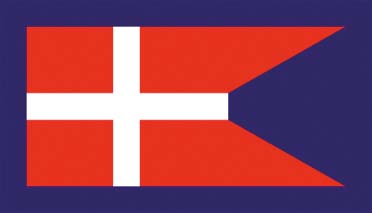
![]() The Dannebrog Group of shipping companies is a long established tramp shipping group, which today operates Nordana Line dry cargo and heavy lift services from the Mediterranean to Caribbean and U.S. ports, and its tankers in a joint venture with Stena Bulk of Sweden from offices in Copenhagen, Houston and Singapore. There are also heavy lift vessels operating worldwide in the project cargo trades for Nordana Line Project and Chartering, and a joint venture with Indonesian palm oil producer Golden Agri-Resources (GAR) operating with specialist palm oil tankers, and a new bulk shipping enterprise.
The Dannebrog Group of shipping companies is a long established tramp shipping group, which today operates Nordana Line dry cargo and heavy lift services from the Mediterranean to Caribbean and U.S. ports, and its tankers in a joint venture with Stena Bulk of Sweden from offices in Copenhagen, Houston and Singapore. There are also heavy lift vessels operating worldwide in the project cargo trades for Nordana Line Project and Chartering, and a joint venture with Indonesian palm oil producer Golden Agri-Resources (GAR) operating with specialist palm oil tankers, and a new bulk shipping enterprise.
The company has used a nomenclature of castles and palaces ending in ‘borg’ e.g. Amalienborg royal palace in the Nyhavn area of Copenhagen. This palace is still lived in by the Queen of Denmark, and is actually one of four buildings that were built on this site for the wealthiest merchants of Copenhagen. The Danish royal family moved here after their earlier palace in Slotsholmen burnt down. Amalienborg has a magnificent four storey facade with a columned projecting portico flying the Danish national flag (known as the ‘Dannebrog’) at its top. Christiansborg palace in Slotsholmen dates from the early 20th century, but there have been palaces and castles on this site since 1147, and twice burnt down in 1796 and 1884. Charlottenborg mansion house fronts Kongens Nytorv in Copenhagen and was completed in 1683 as a royal palace, but since 1754 has housed the Kongelige Kunstakademi featuring modern art by Danish and international artists.

Early History
The first half of this long period of tramp shipping was operated in the traditional deep sea tramping trades with steam and motor tramps in the 5,000 to 8,000 dwt range. Tramping around the world in stout steam tramps was a very good way to earn good freight rates as well as for officers and crew to see the world, unlike cargo ships on liner voyages that always repeated the same sequence of ports. The bright Dannebrog funnel colours feature the ‘Dannebrog’, and were seen on tramps carrying cement in wooden barrels from Norre Sundby or Aalborg or paper from Norrkoping to American ports, sugar from Havana in Cuba or Port Louis in Mauritius via the Cape to Europe, coal from the Tyne to the Plate returning with grain from Rosario, iron ore from Narvik or Lulea to German and British blast furnaces, or coal from Durban to the whaling station on South Georgia. Round the World voyages lasting up to a year were very rewarding and, for example, visited grain ports in the Black Sea, then loaded tea in Colombo or rice, tapioca and teak wood in Rangoon for Japan, and then ballast to load phosphates on Ocean Island or Nauru in the Pacific to return to Denmark via the Panama Canal. A liner service known as the ‘Baltica Sud Americana Line’ was operated by Dannebrog between 1920 and 1924 from Scandinavian ports to South America, as well as a ‘cross trader’ service between North American and South American ports.
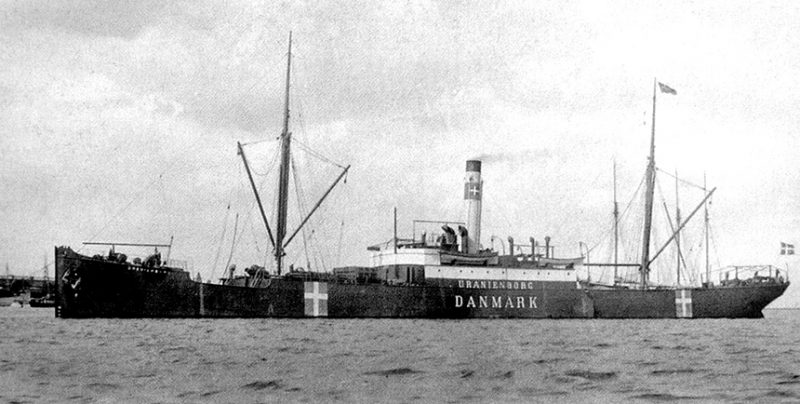
However, the origins of the Dannebrog Steamship Company A/S date back to its formation on 9th February 1883 in Copenhagen to operate in the mundane coal and timber trades of the North Sea and Baltic. The shipbroker C. K. Hansen and his son Johan Hansen put up part of the capital of 900,000 Danish kroner, the remainder raised from Danish businessmen, to order three sister ships of 1,750 dwt from the Copenhagen yard of Burmeister & Wain A/S at a price of 400,000 Danish kroner each. They were named Christiansborg, Frederiksborg and Amalienborg and all of the trio were all in service by June 1884, however the career of Christiansborg lasted only six years as she grounded on 27th July 1889 three miles west of the Ronnskar Lighthouse while on a voyage with Tyne coal to Wasa and the ship was abandoned. Access to the inner docks at Copenhagen with coal was via the Knippelsbro bridge, with Uranienborg of 1894 stuck against the raised bridge for a whole day on 6th June 1900.
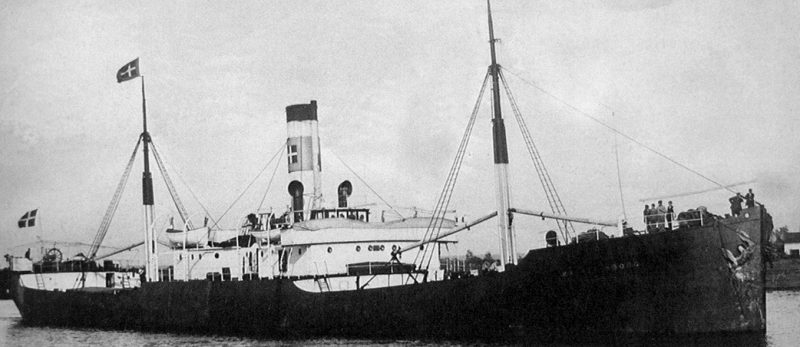
The Steamship Company A/S of 1896 and the Neptune Steamship Company A/S were set up for financial reasons, and were merged into the Dannebrog Steamship Company A/S in 1918 for tax reasons. No fewer than 26 small North Sea and Baltic traders were ordered from North East Coast shipbuilders or purchased second hand from North East Coast shipowners between 1889 and the years immediately preceding World War I. Fifteen came from Hartlepool or Teesside yards, six ships from Wear shipyards, three from Tyneside yards and two from the Blyth Shipbuilding Co. Ltd. Another subsidiary was used to register nine of the fleet of twenty tramps and general traders of P. L. Fisker of Copenhagen, who had been bankrupted in 1910. These were Jungshoved of 6,400 dwt, Hammershus of 6,750 dwt, Esrom of 5,200 dwt, Lejre of 4,360 dwt, Gurre of 4,360 dwt, Borglum of 4,125 dwt, Oskild of 4,088 dwt, Jelling of 4,125 dwt, and Kalo of 3,200 dwt, all of which were managed in gainful employment for two years before being purchased and transferred to the ownership of the Dannebrog Steamship Company A/S in 1912. Johan Hansen died in 1913 after serving as a Copenhagen shipowner for thirty years in his Toldboden office, with the owning Hansen family descendants taking over.
World War I
The fleet had grown considerably in size to twenty steamers at the start of the new century in 1900, and then doubled gain to 42 steamers of 137,000 grt in August 1914 when the First World War broke out. A staggering twenty of these ships and sixty company seafarers were lost to enemy action:-
- Marselisborg disappeared in December 1914 while on a voyage from Pensacola to Copenhagen with oil cakes, and passed Norfolk (Va) on 24th December, all lost.
- Soborg torpedoed and sunk by a German submarine on 30th May 1915 about 45 miles NE of Longstone Lighthouse while on a voyage from Copenhagen to the Tyne to load coal for the Mediterranean.
- Skodsborg torpedoed and sunk in the North Sea on 20th March 1916 five miles SSW of Corton Lightship whilst anchoring during a voyage from New Orleans to Helsingborg via Norfolk (Va) and Dartmouth.
- Stjerneborg torpedoed and sunk on 5th April 1916 in the Mediterranean to the south of Sardinia by an Austrian submarine while on a voyage from the Tyne to Bagnoli with coal, the lifeboats reached the Bay of Cagliari in the evening.
- Jaegersborg captured by a German submarine on 4th August 1916 when 12 miles NE of Longstone Lighthouse and sunk by bombs while on a voyage from Narvik to the Tees with iron ore, all saved.
- Guldborg captured and sunk in the middle of the North Sea on 20th October 1916 while on a voyage from Narvik to the Tees with iron ore, all saved.
- Dansborg captured and sunk by a German submarine on 22nd December 1916 when 28 miles NW of Guernsey while on a voyage from Sunderland to Lisbon with coal, all saved.
- Naesborg captured and sunk by a German submarine on 4th January 1917 off Guernsey in the English Channel thirty miles NW of Sept. Iles while on a voyage from Sunderland to Bayonne with coal, all saved.
- Tuborg captured and sunk by a German submarine on 10th January 1917 in the English Channel to W of Guernsey while on a voyage from Sunderland to Lisbon with coal, all saved.
- Klampenborg torpedoed and sunk in the Bay of Biscay about 20 miles SE of Armen Rocks on 19th January 1917 while on a voyage from the Tyne to Bordeaux with coal, all saved.
- Rosborg torpedoed and sunk in the North Sea on 3rd March 1917 100 miles E of Buchan Ness while on a voyage from Baltimore to Aarhus via Kirkwall with maize.
- Kallundborg captured and sunk by a German submarine on 5th June 1917 80 miles SSW of Toulon while on a voyage from Genoa to Bougie in ballast.
- Vordingborg captured and sunk by a German submarine on 11th July 1917 in the English Channel 25 miles NE of Ushant while on a voyage from Cardiff to Huelva with coal, all saved.
- Harrildsborg torpedoed and sunk in the North Sea 24 miles W of Holmengra on 19th July 1917 while on a voyage from Methil to Copenhagen with coal.
- Flynderborg torpedoed and sunk on 21st October 1917 five miles off Noss Head near Wick while on a voyage from Copenhagen to Leith via Bergen, all saved.
- Ulfsborg torpedoed or mined in the Bay of Biscay on 23rd October 1917 while on a voyage from Bilbao to Newport with iron ore, 17 lost.
- Guldborg torpedoed and sunk in the Irish Sea on 5th February 1918 when 18 miles from the Kish Lightship while on a voyage from Glasgow to Gibraltar with coal, all saved. She had been requisitioned at West Hartlepool after her trial trip in February 1917 and renamed Cresswell and managed by Furness, Withy & Co. Ltd., and was sunk under this name.
- Randelsborg sunk by gunfire from a German submarine on 9th March 1918 in the Skagerak while on a voyage from Copenhagen to Methil via Haugesund and Bergen in ballast, all saved.
- Kalo torpedoed and sunk by a German submarine on 13th June 1918 18 miles ESE of Flamborough Head while on a voyage from the Tyne to Pauillac with coal, 3 lost.
- Uranienborg mined and sunk on 23rd November 1918 in the Kattegat about six miles SSE of Skagen Lighthouse while on a voyage from Sunderland to Copenhagen via Bergen and Mandal with coal, 1 lost.
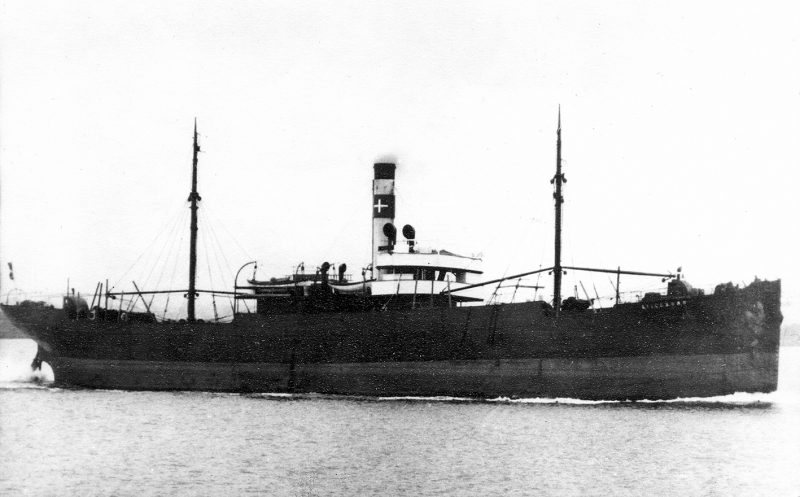
The former Lilleborg of 1,400 dwt was requisitioned at Rouen in August 1914 by the French Government and fitted out as the decoy Q ship Marguerite VI, and served throughout the war, sinking a German submarine on 17th June 1917 in a gun duel in which she was badly damaged. The crew and the vessel were decorated by French President Poincare, and she was repaired at Rochefort and resumed her war service in March 1918 as an escort vessel. Kronborg of 5,700 dwt was ‘impersonated’ by a British sister ship completed as Rubens in 1906 at West Hartlepool and taken as a prize at Hamburg on the outbreak of war. She left Wilhelmshaven on 18th February 1915 as Sperrbrecher A, and then off the Norwegian coast she was repainted as Kronborg in Dannebrog funnel colours, and with her holds full of ammunition and coal, sailed to East Africa to help the German cruiser Konigsberg locked up in the Rufiji river. However, she was intercepted after putting into Aldabra for repairs to engine trouble by the British cruiser Hyacinth from her radio signals to Konigsberg. She managed to get through the narrow entrance to Manza Bay but was shelled and set on fire by the British cruiser, denying the coal for Konigsberg, although her ammunition and stores were later salvaged by her German crew.
Inter-War Years
A big newbuilding programme of sixteen steamers was begun in 1919 with British, Dutch and Scandinavian shipyards, resulting in Amalienborg of 4,840 dwt, Aalborg of 1,900 dwt, Christiansborg of 5,240 dwt, Dansborg of 7,400 dwt, Ellensborg of 1,950 dwt, Flynderborg of 2,400 dwt, Fredensborg of 3,160 dwt, Jaegersborg of 1,950 dwt, Klampenborg of 420 dwt, Orneborg of 2,825 dwt, Skodsborg of 2,445 dwt, Soborg of 3,270 dwt, Sonderborg of 4,850 dwt, Tuborg of 700 dwt, Uranienborg of 6,000 dwt, and Viborg of 3,400 dwt. In addition, a steam tramp of 5,115 dwt was ordered from the yard of Helsingor Shipbuilding and Engineering Company A/S, but the agreement was cancelled in December 1920 due to a shortage of steel plates. In 1922, the contract was taken over by the Norden Steamship Company A/S, and the vessel was eventually delivered as a shelterdecker in 1924 under the name of M. C. Holm. The Dannebrog Marine Superintendent supervising this big newbuilding programme was H. Neergaard, and the Superintendent Engineer was H. Sorensen, both working from the new outstanding stone Dannebrog office building at Amaliegade 35, and constructed during 1921/22.
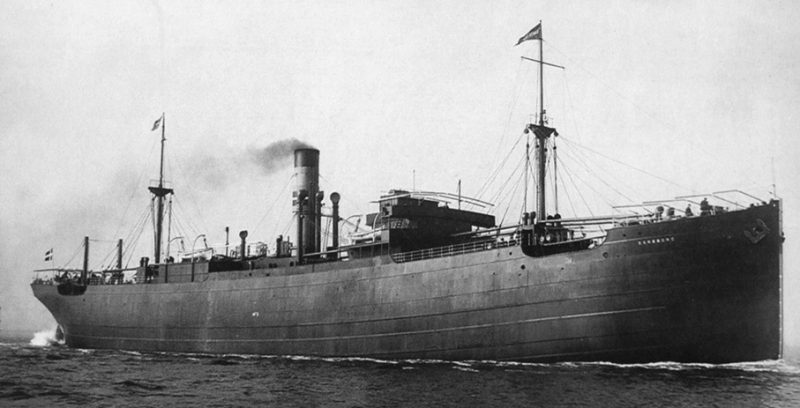
The biggest tramp in the fleet was now the steamer Dansborg of 7,400 dwt, built by the Stockton yard of Richardson, Duck & Co. Ltd. in 1920. She had dimensions of 396.8 feet overall, beam of 51 feet with a well deck forward and a well deck aft, fo’c’stle of length 37 feet, bridge deck of length 244 feet, and poop deck of length 38 feet. A triple expansion steam engine by Blair & Co. Ltd. of Stockton produced a service speed of ten knots. She was used on the Baltica Sud Americana Line service of Dannebrog, making eight round voyages, plus worldwide tramping until sold in 1933.
The worldwide inter-war voyages of the similar tramp Jungshoved of 6,400 dwt built in 1901 by the John Blumer yard at North Dock in Sunderland as Pennmanor for British owners are very revealing. She was used from 10th May 1919 until late December 1924 on the Baltica Sud Americana service, making ten round voyages, carrying cement in wooden barrels from Norre Sundby and Aalborg outwards to North American ports, returning homewards from South American ports. She was then employed in the sugar trade from Cuban ports to American ports, as well as for voyages to South American and Mediterranean ports, with two cargoes of coal imported into British ports in the Autumn of 1926 during a coal strike. She sailed from Bremen in October 1927 with coal for Lourenco Marques, and then loaded sugar at Port Louis in Mauritius for Horsens via the Cape. She sailed from Rio de Janeiro for the last time in late January 1930 with wheat for Livorno, and then was engaged for the rest of 1930 with British coal cargoes for Oran, returning with phosphates from Casablanca. She arrived at Norre Sundby at the end of her last voyage with phosphates on 14th December 1930 and was laid up. She was broken up at Aalborg in December 1932, but remarkably her bridge and saloon found a new use as a part of a clubhouse of a yachting club at Aalborg. They then were used in various capacities for the next fifty years until dismantled in 1982 due to deterioration of their steel bulkheads.

A total of 76 round voyages were made on the Baltica Sud Americana Line service from the beginning of 1920 until the end of 1924. Sonderborg of 4,855 dwt made the most voyages, eleven in all, on the service, with Hammershus of 6,750 dwt making nine voyages, Jelling of 4,125 dwt making eight voyages, Orkild of 4,088 dwt making seven voyages, Christiansborg of 5,240 dwt making six voyages, Kronborg of 5,700 dwt making four voyages, and Amalienborg, Borglum, Fredensborg and Uranienborg of up to 6,000 dwt each making three voyages, and Viborg of 3,400 dwt making one round voyage. The service was monthly, or occasionally fortnightly, and usually the sailing was on the first day of the month from Copenhagen, Norre Sundby, Aalborg and Hamburg to Bahia (Sao Salvador), Rio de Janeiro, Santos and Buenos Aires, returning with coffee, grain and foodstuffs to Europe.
At the beginning of 1930, the fleet numbered 29 ships, of which 21 were laid up during that year due to the serious slump in freight rates of the Depression. This included two twin screw new sister motorships of 8,400 dwt delivered from the Copenhagen yard of Burmeister & Wain A/S in April 1929 and February 1930 as Stjerneborg and Guldborg. They had a split profile with the engineers accommodation separated from the officers accommodation, two masts and a set of posts with a dozen derricks for cargo handling. They had service speeds of eleven knots from twin six cylinder B & W diesels of 2,500 bhp, but those of Guldborg were hardly used as she was sold from lay up in August 1933 to Leif Hoegh A/S of Oslo and renamed Hoegh Trader. Two tramps were lost to marine causes in 1930, the first was Sonderborg on New Year’s Day when she ran aground on Harris in the Outer Hebrides while on a voyage from Ardrossan to Trondheim in ballast and became a total loss, the second was Flynderborg on 13th March when she stranded near Ushant while on a voyage from Casablanca to Norresundby with phosphates and became a total loss, all crew members being saved in both shipwrecks.
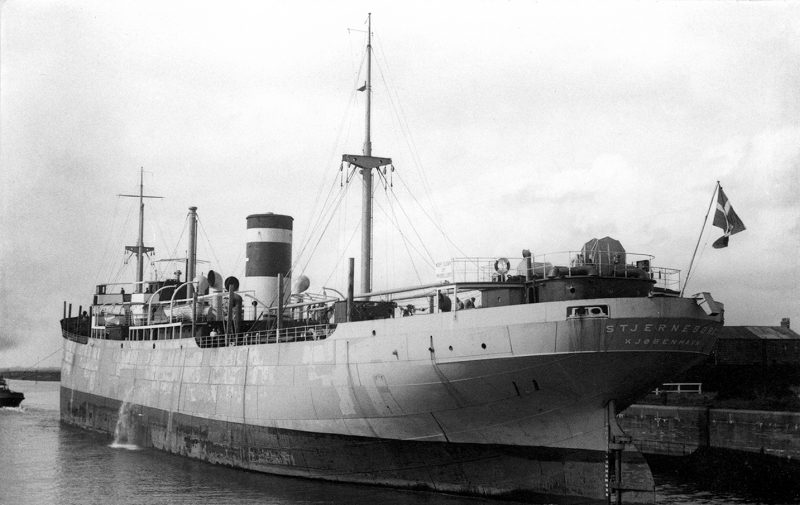
The share capital of the Dannebrog company was reduced by 70% in 1932 to more accurately record its true value in such depressed freight rates, and a dozen ships were sold off or scrapped by 1935 to leave a fleet of seventeen ships. This Danish fleet built in British, Dutch and Danish yards traded in the North Sea, Baltic, Mediterranean and worldwide tramping trades until the outbreak of World War II on 3rd September 1939.
World War II
The contribution of the Scandinavian Merchant Marines to the final Allied victory should not be underestimated. Some 6.6% of all dry cargo arriving in British ports during the war and almost double that figure for oil cargoes was carried in Norwegian ships, with many further cargoes carried in Danish ships. A total of over fifty neutral Norwegian ships were lost to enemy action during the period before Denmark was invaded on 9th April 1940, and German forces began a six week long campaign of fighting in Norway a day later. The Danish and Norwegian ships that were captured in their home ports, including those that always traded in coastal or Baltic trades, constituted the Home Fleet controlled by Germany. Those deep-sea ships that were spread around the world were radioed to make for the nearest port to await requisition by the Allies. A staggering total of 625 Norwegian ships of 2,393 million grt were lost to enemy action during the war, together with nine floating whale factories and their 28 attendant whale catchers. The Norwegian fleet that operated for the Allies came under the control of the Nortraship organisation, staffed by Norwegian shipping personnel with headquarters in London. Some 60% of the Danish merchant fleet that escaped German control and sailed to Allied ports were sunk by enemy action with the loss of over six hundred brave Danish seafarers.
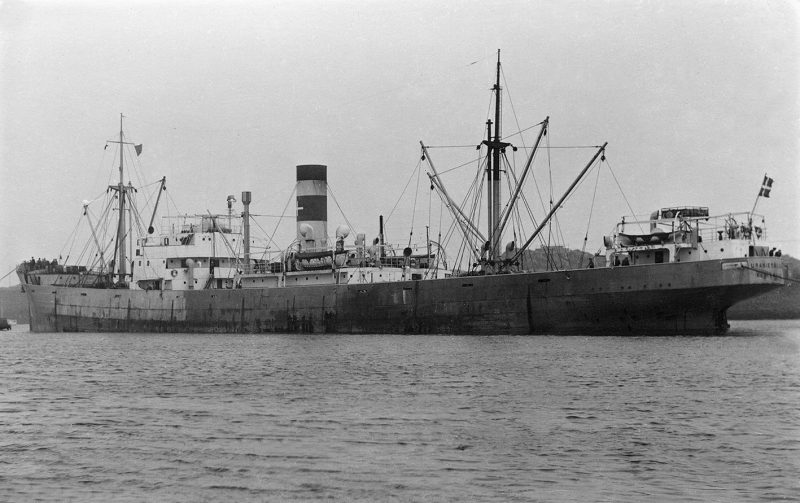
Maersk Line of Denmark lost two dozen deep-sea ships during the war with several more lost to marine causes, DFDS also lost two dozen ships and over 300 brave Danish seafarers, Lauritzen lost two thirds of its big pre-war fleet of thirty ships, East Asiatic Company (EAC) lost thirteen deep-sea ships, Dannebrog lost eight ships, Norden lost two ships, Skou lost two ships, and Torm had only three ships left from a pre-war fleet of fifteen ships. Dannebrog had lost three ships by the time Norway was overrun by German forces, eight company vessels then formed the Home Fleet controlled by Germany, while six company ships escaped to serve the Allied fleets until victory in 1945.
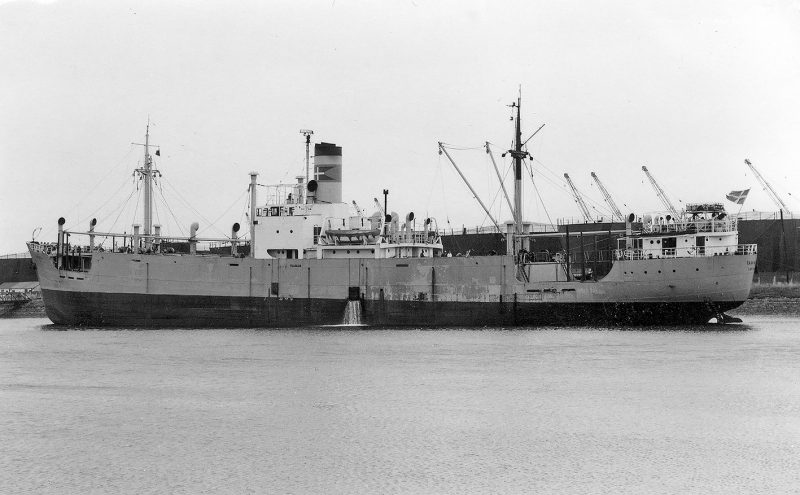
Uranienborg of 6,300 dwt owned by Dannebrog was one of the six escapees and was en route in the Indian Ocean on charter to the East Asiatic Company (EAC) on a voyage from the Dutch East Indies to Denmark at the time of the German occupation, and she put into Aden on 13th April 1940 as instructed by radio. She was requisitioned by the British Government at Aden twenty days later and ordered to discharge her cargo in London and came under the management of Chapman & Willan of Newcastle. She then carried twenty valuable cargoes in convoy to British ports during the war, including wheat, flour, sugar, iron ore, lumber, copper, aircraft and aircraft parts, oilcakes and many more useful commodities. She carried three outward cargoes of coal to Freetown returning with iron ore from Pepel, suffered two collisions while in convoy as well as heavy weather damage that strained her hull to the limit, but she was always patched up ready for the next outward convoy. She arrived at Leith on 14th September 1945 with lumber at the end of her last voyage under British control and was handed back to Dannebrog control that day. However, it took eight months of long and careful repairs at the Elsinore yard of Helsingor Shipbuilding and Engineering before her battered hull was ready for peace time trading.

Eight valuable Dannebrog ships working for the Allied cause were sunk during the war, with two more seriously damaged by the explosions of mines, and the tragic loss of 71 Danish seafarers. The ships lost were:-
Jaegersborg disappeared in the North Sea on 16th December 1939 while on a voyage from Copenhagen to Leith with agricultural products, all 18 crew lost.
Fredensborg torpedoed and sunk by U20 on 27th January 1940 20 miles east of Copinsay Island in the Orkneys while on a voyage from Copenhagen to the Tyne in ballast to load coal, all 21 crew lost.
Christiansborg torpedoed on 12th April 1940 by U38, breaking in two off the Orkneys while on a voyage from Philadelphia to Fredericia with maize. The bow section sank, and salvage of the stern section was considered impractical and was sunk by gunfire 36 miles WNW of Sumburgh Head, one crew member lost.
Flynderborg torpedoed and sunk by U202 on 3rd November 1941 off the eastern entrance to Belle Isle Strait while on a voyage from Parrborough to London with timber, three crew lost with the remainder picked up by a convoy escort vessel and landed at St. John’s (NFL).
Stjerneborg torpedoed and sunk to the east of Dominica Island 427 miles ENE of Barbados by U156 on 12th May 1942 while on a voyage from Halifax to Alexandria via the Cape with war material, all crew saved. She had been taken over at Balikpapan on 9th April 1940 by the Dutch East Indies Government under the management of Rotterdam Lloyd, and was sailing under the name of Koenjit at the time of her loss.
Aalborg torpedoed and sunk in the Mediterranean off Cape Bear on 12th April 1943 by the British submarine Unruly with a German crew onboard. She had been requisitioned by Germany after being taken over at Safi by Vichy French forces.
Rosenborg torpedoed and sunk by U386 on 24th April 1943 around 400 miles west of the Shetlands while on a voyage from Reykjavik to Swansea in ballast.
Viborg torpedoed and sunk by a Russian submarine on 28th January 1945 whilst at anchor off Rugenwalde Lighthouse near Stettin, her crew were saved by a German pilot vessel. Germany had ordered all coal cargoes to be positioned in the Baltic as the war neared its end.
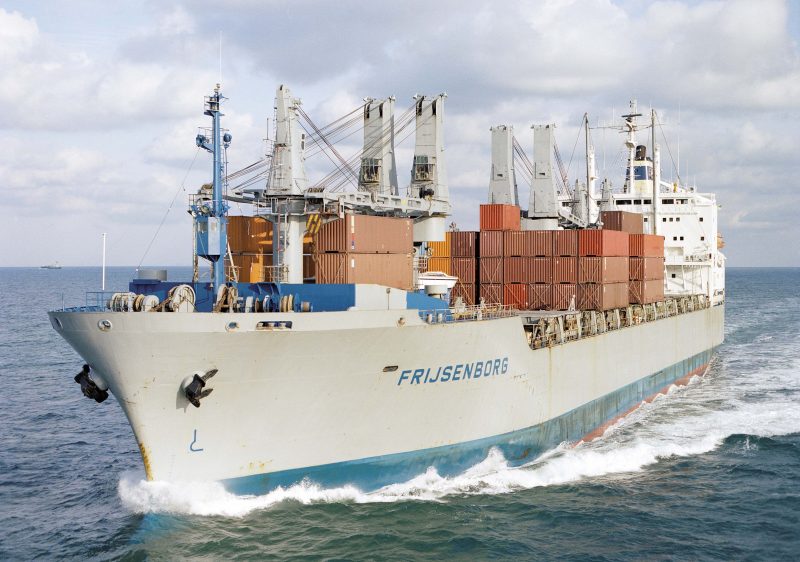
Post-War Years
The nine Dannebrog war survivors included Uranienborg of 1922, Frederiksborg of 1916, Lilleborg of 1916 and Silkeborg of 1915, as well as two new ships that were completed by Danish yards during the war and then laid up at their builder’s quay with their engines disabled by the removal of vital parts. The motor tramp Dansborg of 8,920 dwt was reactivated at the end of the war after completion by Burmeister & Wain in April 1944, and was then time chartered to liner companies as she had a good turn of speed of 13 knots from an eight cylinder two stroke single acting diesel by her builders. The steamer Taarnborg of 3,674 dwt was completed in July 1944 at Aalborg as a timber carrier with deep well decks fore and aft, and was reactivated by August 1945 and converted to oil firing in 1947.
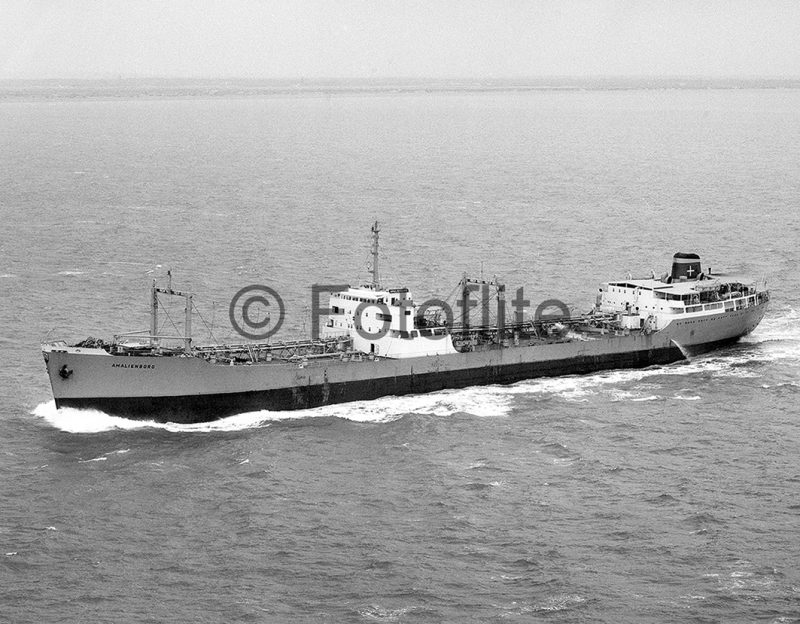
Four new ships formed the replacement tonnage, one being probably the last standard Hansa ‘B’ type to be completed. Brattingsborg of 5,200 dwt had been launched at Aalborg on 28th March 1946 and was sold the following day to Dannebrog, and completed fifteen months later in June 1947. Three ships of 3,530 dwt were ordered from the West Hartlepool yard of William Gray & Co. Ltd. and were completed during 1948/49, again for time charter to American and Canadian companies, and traded for a lot of their service into the Great Lakes from the Caribbean as Aggersborg, Flynderborg and Spigerborg. The last steamship with a reciprocating engine boosted by a low pressure turbine for the Danish merchant fleet was completed as Harrildsborg of 3,523 dwt in July 1953 from a yard at Solvsborg, and she was equipped with ten derricks on two bipod masts to serve her twin holds via four hatches.
A decision was then taken in 1950 to diversify with their fellow Danes of Torm and Lauritzen to enter the tanker market. A joint order for five identical tankers of 16,500 dwt was placed with the Lindholmens yard in Gothenburg.
Dannebrog was cautious enough to order only one tanker, Christiansborg, and she was placed on a five year time charter to an oil major. The results were so successful that Dannebrog purchased or ordered a further five tankers in the 16,000 dwt to 19,000 dwt range for long time charters, the last being delivered as Rosborg in May 1957 at Osaka by the Hitachi yard. The fleet in 1959 comprised a dozen deep sea vessels plus the small coasters Buccaneer and Jelling for coastal coal shipments. The last coal fired Dannebrog ship, Nordborg of 1930, was sold off in 1958 as coal was becoming expensive as bunkers.


An entry into the parcel tanker trade was made in November 1962 with a new tanker Amalienborg of 19,586 dwt, equipped with 27 stainless steel tanks and piping systems. Two further chemical and oil product tankers of 20,438 dwt were completed by the same Hitachi yard at Osaka as Tuborg in December 1965 and Viborg in July 1966. The position of the navigating bridges of this pair at ‘midships with engines aft showed that Dannebrog was conservative in its approach to tanker design, as navigating bridges had moved aft in all of the big oil major fleets by the early 1960s.
Change In Ownership And Management
An 18% shareholding in the Dannebrog Steamship Company A/S was taken in May 1967 by a consortium of Baron Ebbe Wedell-Wedellsborg, Count Tido Weddell, and Christian Kjellerup Hansen of the fifth generation of the owning Hansen family. The long established firm of C. K. Hansen resigned as managing owners at the same time and returned to their shipbroking activities. The new firm of Weco Shipping I/S took over as manager of the Dannebrog fleet of five tankers, and three new dry cargo ships of 2,550 dwt in Skanderborg, Frederiksborg and Flynderborg. Several small coasters were also managed for other owners by the new company, which began by trading and managing a fleet of a dozen ships.
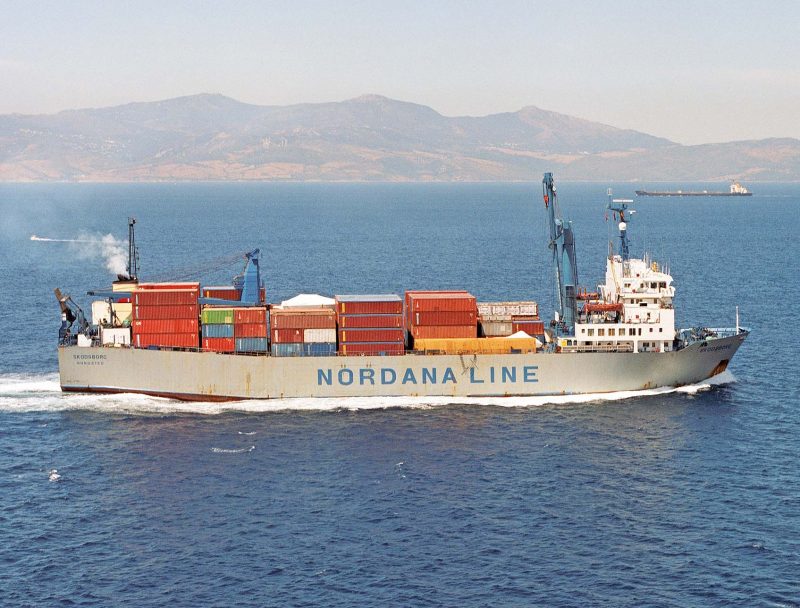
The fleet had expanded by 1970 with another six new coastal product tankers in Billesborg and Brattingsborg of 3,540 dwt, Amalienborg and Aggersborg of 1,320 dwt, Skodsborg of 730 dwt and Lilleborg of 478 dwt. A bitumen tanker, Charlottenburg of 927 dwt, and a larger purchased product tanker Dansborg of 13,006 dwt were taken on time charter, that of the latter ship was to Burmah Oil for Transatlantic voyages into Manchester. Billesborg and Brattingsborg were chartered for over four years from October 1975 to Petrangol of Angola for a shuttle crude oil transfer service from Cabesa de Corbra to supertankers anchored off the Angolan oilfields.
Shipbuilding became another arm of the Dannebrog business in 1971 when the yard of Arhus Flydedok A/S in Jutland was acquired. This yard was renamed Dannebrog Vaerft A/S and had one building berth for vessels up to 120 metres in length, and two floating docks for the repair of vessels also of up to 120 metres in length. The shipyard was renovated at a cost of 140 million Danish kroner to secure the jobs of its six hundred workers, and was a profitable enterprise for eighteen years until an empty order book in 1989 forced its sale. The three largest ships built by the Dannebrog yard were all cement carriers owned by the Aalborg Portland Cement Fabrik A/S in Portland of 4,420 dwt (Yard 164 in 1977), the twin screw Kongsdal of 7,465 dwt (Yard 173 of 1980), and Norden of 7,682 dwt (Yard 187 in 1985).
The headquarters of the Dannebrog Group had moved in 1969 fifteen miles north of Copenhagen to Rungsted Kyst on the coast of the Oresund. ‘Soholm’ is a set of handsome two storey ochre and red roofed buildings of traditional design, with one having a triangular pediment and flagpole flying the company houseflag, and currently houses the staff of several Dannebrog businesses.
The Dannebrog fleet in 1975 was one of three deep sea product tankers, Tuborg, Viborg and Team Dansborg, as well as eight coastal tankers, and another fleet of eight anchor handling tugs and oil rig supply vessels. The latter octet had been completed in 1974 for North Sea oil work, but was sold within a year to the Government of the People’s Republic of China to work in the South China Sea oilfields. Team Dansborg of 19,914 dwt had been completed in 1962 at Bergen as Vega for Bergen Line and was renamed Team Vega in 1970 and sold to Dannebrog in October 1973 and renamed Team Dansborg. The ‘TEAM’ consortium was a Bergen grouping of Bergen Line and Rolf Wigands Rederi A/S, which ordered six tankers of 32,700 dwt for the caustic soda trade from the Horten Verft yard for delivery during 1971/73. Team Dansborg was delivered from her ‘TEAM’ charter in December 1975 at Osaka, and was sent to the Keppel Shipyard in Singapore in May 1976 to be converted into a sheep carrier. She sailed from Portland (Victoria) in Australia on 5th October 1976 with her first cargo of 30,000 sheep for the Middle East, and continued in this trade until laid up at Fremantle in July 1984.

The OPEC oil price hike in October 1973 had devastating consequences for all tanker owners including Dannebrog. The Danish company sold six tankers at the end of 1975 in an effort to reduce its exposure to extremely low tanker freight rates and a very low worldwide oil demand. One further deep sea tanker, Rosborg of 21,154 dwt, built as Haukanger in 1958 for Westfal Larsen, was purchased on 16th June 1976 but not for oil trading, and she was also sent to the Keppel Shipyard at the same time as Dansborg for conversion into a sheep carrier. She began a five year charter at Fremantle on 27th October 1976 to carry sheep to the Middle East, and later served in the same trade between South America and Libya before being laid up at Kalamata in Greece on 9th July 1984. Two further sheep carrier conversions in 1981, Viborg, the former cargo-liner Labrador of DFDS and last of its kind for DFDS, carrying 36,000 sheep, was sold in 1984 as the trade was taken over by State owned Arab companies, and Elsborg, the former Hoegh Aurore and carrying 13,100 sheep, was renamed Ilongo in 1985 for trading from the Philippines and carried her last sheep in December 1990.
The Aframax crude oil tanker Ulfsborg of 70,640 dwt sailed from Yokohama on 17th March 1980 after purchase for a three year time charter to Petrangol of Angola as a crude oil shuttle tanker from the offshore Quifuquena terminal to the refinery at Luanda. She was not required for two months from November 1981 as the shore tanks at Luanda had been blown up by guerrillas, and Ulfsborg was loaded with as much as possible of the contents of the destroyed tanks and sailed for Antwerp. She returned to Luanda two months later after new tanks were completed to resume her shuttle service.
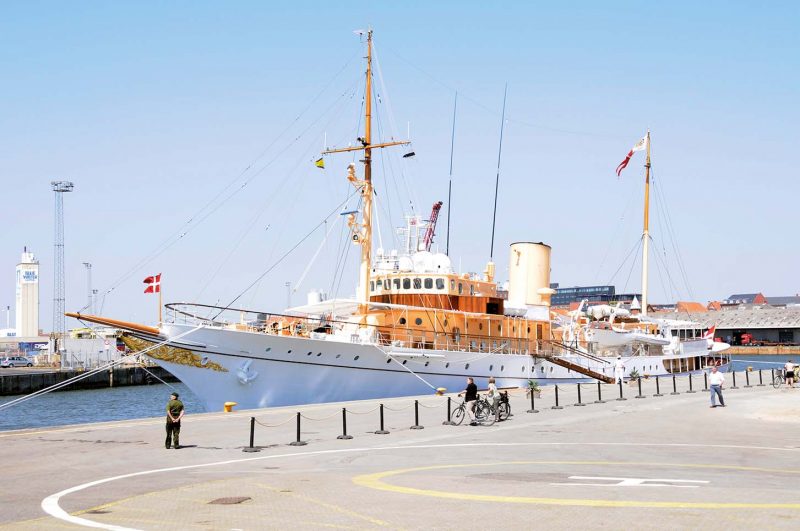
Liner And Ro-Ro Services
Dafra Line with services from Hamburg, Bremen, Rotterdam and Antwerp to West African ports including Boma and Matadi on the river Zaire in the Republic of Zaire, and Pointe Noire in Congo, was purchased from financially troubled Dansk-Franske D/S A/S of Copenhagen in August 1978 for 70 million Danish kroner. Four second hand cargo-liners in the 12,000/13,000 dwt range as closed shelterdeckers named Kinshasa, Banana, Bretagne and Africa, were renamed Stjerneborg, Skodsborg, Christiansborg and Charlottenburg. They had a dozen derricks on two goalpost masts and two sets of posts plus two deck cranes for cargo handling of heavy logs and other West African cargo. Dafra Line brought valuable liner service know-how to Dannebrog, and gave it the confidence to buy Nordana Line from DFDS in early 1984, together with four new ro-ro ships that were operated on bareboat charter from their Japanese builders of Nippon Kokan. Dana Africa, Dana America, Dana Arabia and Dana Caribia were renamed as Skodsborg, Stjerneborg, Skanderborg and Schackenborg at the end of their bareboat charters in February 1984.
Two of the Dafra Line quartet were sold in 1983 and replaced by two larger cargo-liners of 22,300 dwt purchased from Knut Knutsen of Haugesund as Marie Bakke, renamed Frijsenborg, and John Bakke, renamed Wedellsborg. This pair had operated a joint Pacific service with East Asiatic Company (EAC), and could load 800 TEU of containers by seven deck cranes (four of 35 tonne capacity and three of 16 tonne capacity) into two cargo holds and five fixed guides cellular container holds or as deck cargo. However, Dafra Line was sold to CMB of Belgium in 1988 with Dannebrog continuing to manage the service for four years until the Antwerp office of CMB took over.
The 120 tonne heavy lift jumbo derrick and a 36 tonne capacity deck crane of each of the Nordana Line ro-ro quartet came in very useful on their service from the Mediterranean ports of Cadiz, Alicante, Valencia, Barcelona, Marseille, Genoa, Livorno, Piraeus, Mersin, Iskenderun, Limassol, Beirut and Alexandria to Caribbean and Central American ports, returning via Houston, New Orleans, Charleston, Baltimore and New York to the Mediterranean. The Nordana Line service ran initially every three weeks and was very profitable and continues in service today. Stjerneborg, the former Dana America, was sold in 2002 to Dem Line of Egypt, to whom she had also been on charter, and was renamed Fast Challenger, and her three sisters were lengthened at the same time at Tuzla in Turkey to increase their lane length to 1,884 metres and TEU capacity to 655 containers and ran on Nordana Line services for another decade.
Nordana Project and Chartering was set up in 1998 as an independent division of Nordana Line to broaden its activities as a worldwide tramp service. An expanded service with a dozen ships in 2007 named Aalborg, Charlottenburg, Frederiksborg, Frijsenborg, Marienborg, Naesborg, Nordborg, Rosborg, Skodsborg, Skanderborg, Schackenborg, and Wedellsborg traded worldwide. This has today increased in a rapidly changing environment to an average of twenty owned and chartered ships in the 5,000 to 30,000 dwt range, with some of these having traditional Dannebrog names ending in ‘borg’, and some having names with the prefix ‘Nordana’, plus long term chartered ships with various names. Four of these are the ro-ros Stjerneborg, Wedellsborg, Wilhelmsborg and Williamsborg with lane lengths up to 2,900 metres and TEU capacity of 900 containers, while the remainder have a heavy lift capability of either twin 150 tonne or 250 tonne cranes to give a combined lift of 300 or 500 tonnes. An extensive agency network in the Caribbean plus freight forwarders in the headquarters Dannebrog offices in Houston, New Orleans and New York are responsible for finding liner and project cargoes for this big fleet.

Privatisation Of Dannebrog
As a consequence of the very weak prevailing freight rates at the end of 1987, the Dannebrog fleet had been reduced to only six owned ships. A financial restructuring of the company then took place, with the company delisted from the Copenhagen Stock Exchange in 1988, and the minority shareholdings taken over by the Wedell-Wedellsborg family to become a completely private shipping company. The fleet was managed by Ebbe Wedell-Wedellsborg and his son Ditlev, and comprised the Nordana Line owned ‘S’ class quartet of ro-ros plus two ro-ros engaged in the North Sea trades as Naesborg and Nordborg, and two chartered tankers, Dansborg of 7,177 dwt and Rosborg of 6,756 dwt. A new owned chemical tanker of 7,580 dwt was purchased on 15th July 1991 and renamed Dansborg. She was the only owned tanker of Borg Tankers between 1991 and 1998, and was deployed in the chemical trades from refineries in Rotterdam and Houston.
A new departure for Dannebrog was the operation of the small ferry Lundeborg of 683 grt with accommodation for 238 passengers and 45 cars between 1992 and 1996 on a service between Korsor on Sjaelland and Lohals on the island of Langeland. The North Sea ro-ros Naesborg and Nordborg were sold off in 1994, Naesborg going to Greek owners, first as Attika and then Euromagique, and Nordborg to DFDS and renamed Dana Hafnia. The owned fleet in 1998 comprised the Nordana Line ‘S’ quartet, the chemical tanker Dansborg of 7,580 dwt, and the new double hull chemical tanker sisters Aggersborg and Amalienborg of 16,775 dwt completed in 1998 at Mobile (Alabama) with a dozen cargo pumps each operating at a capacity of 300 tonnes per hour for rapid discharge of her parcel chemical cargoes. The Handysize tanker Christiansborg of 40,000 dwt followed two years later, and Dannebrog and MACS Maritime Carrier Shipping introduced a joint liner service between the U.S. Gulf and South Africa at this point in time with
Stena Weco Tanker Fleet
Stena Bulk A/B of Sweden in January 2011 acquired a 50% shareholding in Weco Shipping I/S, part of the Dannebrog Group. Weco Shipping I/S was at this point of time a market leader in the special products transportation of palm oils, edible oils, caustic soda and speciality chemicals. Golden Agri-Resorces (GAR) was founded in 1996 with all of its palm oil plantations in Indonesia, particularly Kalimantan (Borneo) and Sumatra. It had achieved an output of 2.911 million tonnes of palm 1,130gt products by 2012, and formed a global transportation agreement with Stena Weso A/S and Stena Bulk A/B to transport palm oil from its own jetties.
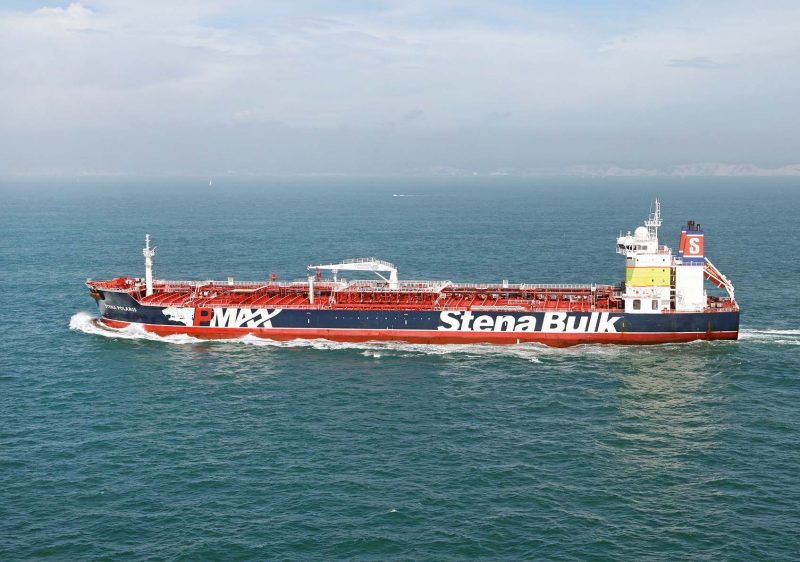
The tanker pool of Stena Weco has offices in Copenhagen, Houston and Singapore and controls a very large fleet of 66 tankers, including the Dannebrog owned Amalienborg and Kronborg of 40,200 dwt, and the 50,000 dwt sisters Stenaweco Gladys W, Stenaweco Marjorie K, Stenaweco Julia L, and Stenaweco Impulse. The six Stena ‘P-max’ class of 65,000 dwt comprising Stena Performance, Stena Progress, Stena Premium, Stena Paris, Stena Polaris and Stena Provence operate alongside the Stena ‘IMO-Max’ class of 49,400 dwt of Stena Image, Stena Immaculate, Stena Immortal, Stena Impeccable, Stena Imperative, Stena Imperial, Stena Important and Stena Impression, the latter being the lead ship completed in January 2015. Many other Stena tankers including their ‘C’ class of 47,500 dwt operate in this very large pool of Medium Range and Handy Size product tankers to make it one of the leaders of this type of tanker operation in the world. Four Medium Range eco-type tankers were chartered in March 2015 from Aegean Shipping of Greece for the pool.
Postscript
The newest addition to the Dannebrog businesses is Weco Bulk A/S, formed on 1st May 2013 for the carriage of bulk cargoes with headquarters in Copenhagen and representative offices in Bangkok, Sao Paulo and Houston. Owned and chartered bulk carriers will be used for worldwide bulk cargoes e.g. grain, iron ore, manganese ore, tin, bauxite, coal, steel, scrap, aluminium, cement, petroleum coke, wood pellets and biomass, and many more bulk commodities. However, the biggest ever Dannebrog ship was a second hand VLCC of 306,430 dwt purchased in 2007 and renamed as Lilleborg. She was completed in 1993 as Berge Sigval and was time chartered to Swiss Tanker Management.
The white hulled twin masted yellow funnelled Danish Royal Yacht is called Dannebrog and was launched in 1931 by the Royal Dockyard at Copenhagen and completed on 26th May 1932 of 1,130 tonnes displacement on dimensions of length 246 feet, moulded beam of 34 feet and depth of 11.2 feet. She can act as a hospital ship during emergency alerts or wartime and has cruised over 300,000 nautical miles during her 84 year career. She has visited the ports of Denmark, Greenland and the Faroes as well as European ports, especially in France, and has also cruised the Mediterranean and the Caribbean. She flies the ‘Dannebrog’ flag, the dimensions of the flag itself are in the proportions of 37 (length) by 28 (depth) displaying a white cross on a red background, the upright of the cross being to the left of centre.
The long tramping history of the Dannebrog Group has built up a tradition of professional worldwide services that have matured into a larger dry cargo and specialist tanker fleet over the last two decades.
The success that is being enjoyed today is fully deserved, and the group will continue well into the future under Managing Director Johann Wedell-Wedellsborg as a major worldwide tramp shipping business. I wish the Danish shore staff at ‘Soholm’ at Rungsted Kyst and their seafarers continued success in the future.
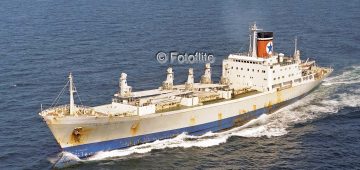
Comments
Sorry, comments are closed for this item